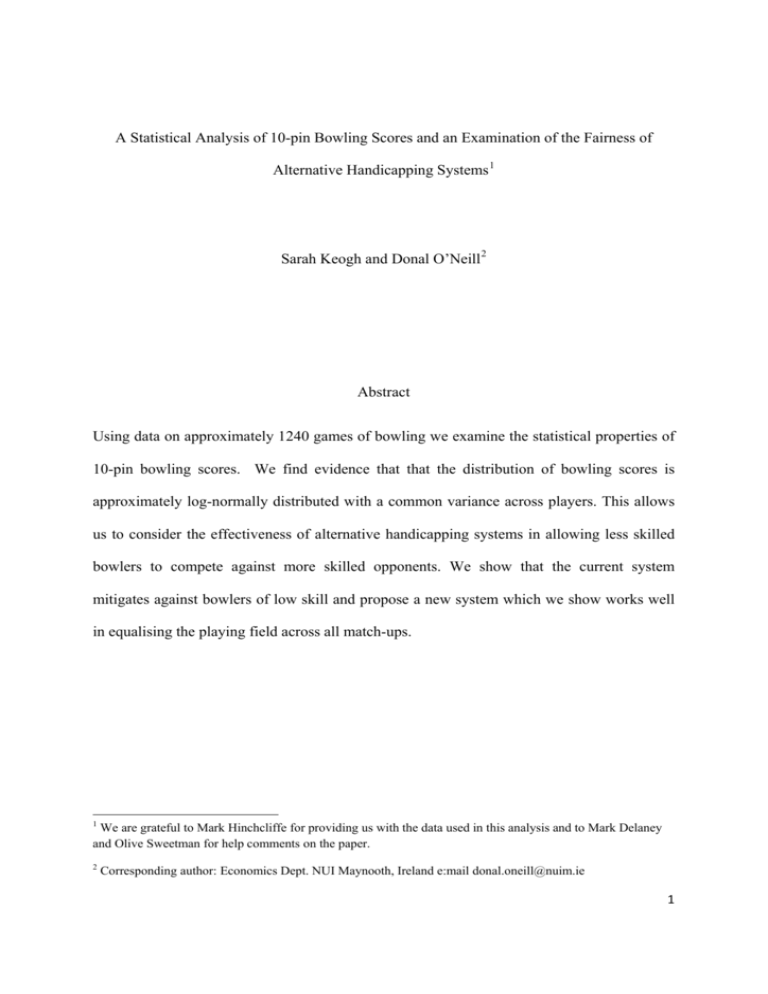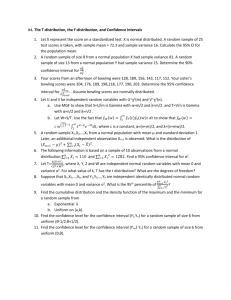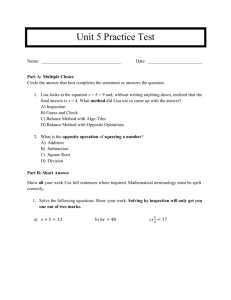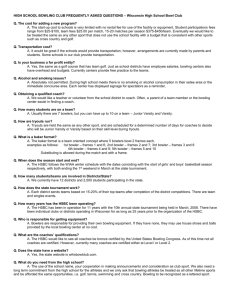A Statistical Analysis of 10-pin Bowling Scores and an Examination
advertisement

A Statistical Analysis of 10-pin Bowling Scores and an Examination of the Fairness of Alternative Handicapping Systems 1 Sarah Keogh and Donal O’Neill 2 Abstract Using data on approximately 1240 games of bowling we examine the statistical properties of 10-pin bowling scores. We find evidence that that the distribution of bowling scores is approximately log-normally distributed with a common variance across players. This allows us to consider the effectiveness of alternative handicapping systems in allowing less skilled bowlers to compete against more skilled opponents. We show that the current system mitigates against bowlers of low skill and propose a new system which we show works well in equalising the playing field across all match-ups. 1 We are grateful to Mark Hinchcliffe for providing us with the data used in this analysis and to Mark Delaney and Olive Sweetman for help comments on the paper. 2 Corresponding author: Economics Dept. NUI Maynooth, Ireland e:mail donal.oneill@nuim.ie 1 I: Introduction Primitive forms of bowling can be traced back as far as 3200BC (www.tenpinbowling.org 2011). Ten pin bowling as we know it, is thought to have originated from the German nine pin bowling game called Kegal (www.tenpinbowling.org 2011). Today, it is estimated that the sport of ten pin bowling is played by over 100 million people in more than 90 countries, making it one of the most popular games played in the world. 3 With this in mind, it’s surprising how little quantitative analysis has been conducted on the sport. Previous research has examined the correlation in scores between balls rolled Neal (2004) using a binomial distribution while Dorsey-Palmateer and Smith (2004) used empirical data to examine the phenomenon of a “hot-hand” whereby the probability of a strike with a given ball depends on the score obtained with the previous ball. There has also been a small body of work looking at the distribution of bowling scores (Cooper and Kennedy (1990) and Hohn (2009)) that did not use observed data. The only paper we are aware of that uses empirical data to analyse the distribution of bowling scores is work carried out by Chen and Swartz (1994), which used data on five pin bowling scores, a less-popular variant of ten-pin bowling played only in Canada. As noted by the authors however, their results cannot be applied to ten pin bowling due to differences in rules, equipment and scoring. In this paper we carry out a statistical analysis of scores from approximately 1024 games of ten pin bowling to determine the distribution of these scores. Since the score of a player in a single score is the sum over a number of frames one might expect something approximating normality if a central limit theorem is in operation. We examine normality of 3 See World Tenpin Bowling Association website http://www.worldtenpinbowling.com/ 2 both the raw scores and a suitably chosen transformation of these scores. We then use the results of this analysis to evaluate the effectiveness of alternative handicapping systems currently used. The latter is very topical among elite bowlers because if a bowler believes a certain handicapping system to be unfair towards them, they will not enter leagues or competitions which use that system. Section II introduces the game of ten pin bowling and describes the data set used in the analysis. The statistical analysis is conducted in section III, while section IV compares current handicapping systems and proposes a new, alternative system. II: The Game and the Data Set Ten pin bowling is a competitive sport in which a “bowler” rolls a bowling ball down the lane with the aim of scoring points by knocking down as many pins as possible. Ten pin bowling balls have a smooth surface bar two finger holes and a thumb hole. They have a maximum diameter of 8.59 in., and range in weight from 6lb. to 16lb. The ball is rolled down a wooden or synthetic lane with the objective of knocking down pins. The pins themselves are 4.75 in. wide at their widest point and 15 in. tall. They weigh 3 lb., 6 oz. The bowling lane itself is 60 ft. from the foul line to the centre of the headpin. Today it is estimated that over 100 million bowlers play the sport in over 90 countries, making it one of the most popular participant sport in the world. A game of ten pin bowling consists of 10 frames. A bowler’s score is the sum of points over the game. Frames 1 to 9 consist of a maximum of 2 legally delivered balls rolled by the same bowler on the same lane. Frame 10 consists of a maximum of three legally delivered balls by the same bowler on the same lane. In a frame of bowling, if a bowler knocks down all ten pins with their first ball, then a strike is awarded. If all ten pins are 3 knocked down using two balls in any frame, a spare is awarded. A strike is worth 10 points, plus the points received from the next two balls rolled. A spare is worth 10 points plus the points received from the next ball rolled. A bowler who bowls a strike in the 10th frame is awarded two extra balls, which allow the awarding of bonus points. A bowler who bowls a spare in the 10th frame is awarded one additional ball to allow for the bonus points. The maximum score in ten pin bowling is 300, and is achieved by having 12 strikes in a row in one game. The typical average score for a woman is 153, and the typical average score for a man is 173. 4 The data set used in this paper was obtained from an adult ten pin bowling league in Alsaa Bowling Centre, Dublin Airport, Ireland. The league is 18 weeks in duration. There are 23 bowlers in this league. These 23 bowlers played 3 games every Monday evening for the 18 weeks. This gives a maximum of 54 games per bowler with possibly some missing values. This results in approximately 1240 games. Bowling scores vary in the data set. The maximum score is 289, bowled by player 20, and the minimum score is 114 bowled by player 16. Skill levels among the 23 bowlers differ. The average scores range from 153 (player 18) to 220 (player 7). Further summary statistics are given in Table 1. III: Analysis a. Raw Scores: The first stage in this analysis will be to investigate if the raw data is approximately normally distributed. To begin we construct kernel density estimates of the underlying density. Kernel density estimation is a non-parametric way of estimating the probability density function of a random variable (Sheather 2004). The kernel density estimates for each of the 23 bowlers are 4 http://www.ten‐pinbowling.com/faq.htm#3 4 given in Figure 1. In these figures a normal density with mean and variance derived from the raw data is also provided for comparison. These graphs show deviations from normality for a number of players For instance results for players 1, 2, 13 and 20 seem to be skewed to the right, while players 5, 21 and 23 seem to have fatter tails that the underlying normal distribution. We supplement this graphical approach with a number of tests. The tests used are the Shapiro-Francia test (Shapiro and Francia (1972), Royston (1983)) and the Skewness Kurtosis test (D’Agostino et al (1990), Royston (1991)). The Shapiro-Francia test equals the squared correlation between the ordered sample values and the expected order statistics of a standard normal and thus measures the straightness of the normal probability plot of the sample values. The Skewness Kurtosis test presents a test for normality based on skewness and another based on kurtosis and then combines the two tests into an overall test statistic. Each test is conducted for each player in the data set. Then the p values are combined using Fisher’s Method (Fisher 1970). Fisher’s method combines p values for each test into one test statistic using the formula: where pi is the p value for the ith hypothesis test. When all the null hypotheses are true, and the pi are independent, P has a chi-squared distribution with 2k degrees of freedom (Fisher 1925). The results for both tests are presented in Tables 2 and 3. For both tests we reject the null hypothesis that all game scores are normally distributed. b. Transformed Scores 5 Having rejected normality of the raw scores we now consider whether it is possible to find a transformation of the underlying scores which is well represented by a normal distribution. To do this we consider Box-Transformations of the scores (Box and Cox 1964, Spitzer 1980). The original form of the Box-Cox transformation, as appeared in their 1964 paper, takes the following form: y( ) y 1 0 ln y 0 Formally we posit the existence of a λ such that bowling scores for player i in game j, yij, can be written as : yij( ) i ij where єij is a draw from a normal distribution with mean zero and variance i2 . Under the assumption of normality the density function for the jth observation of player i, can be written f ij 2 i2 1/ 2 exp ij2 / 2 i2 The likelihood contribution for player i can then be written in terms of observed bowling scores yij : L*i f ij yij 1 j Where the last term is the Jacobian of the transformation from є to y. Taking logs we get T Ti 2 1 i ln L*i c Ti / 2 ln i2 2 i2 yij i 1 ln yij j 1 j 1 6 where c is a constant. The log likelihood function across all players is then: N ln L* ln L*i i 1 Since i is just the mean of yij( ) , we can concentrate it out of the likelihood function by replacing it with its maximum likelihood estimate Ti 1 i Ti yij y i j 1 ^ We can simplify this further by solving for the parameter i2 directly from its first order conditions in terms of the other parameters and the data. The maximum likelihood estimate of i2 is given by : Ti 2 1 Ti yij y i j 1 ^ 2 i Substituting this expression into the individual likelihood function we get a final concentrated likelihood function depending only on and data. Ti yij y i ~ ln L*i c Ti / 2 ln j 1 Ti 2 Ti 1 ln yij j 1 The concentrated log-likelihood across all players can then be written as Ti y y ij i N j 1 * ln L Ti / 2 ln Ti i 1 2 Ti 1 ln yij j 1 7 Maximising the concentrated likelihood function with respect to λ provides an estimated ^ value =-.148 with a standard error of .199 (lnL=-3331.2102). Since we cannot reject =0 (i.e the log transformation) we adopt this for convenience throughout the remainder of the paper. Table 4 gives a brief description of the transformed log bowling scores. The kernel density graphs for the transformed bowling scores of each of the 23 bowlers are given in Figure 2 and the results of the formal tests are given in Tables 5 and 6. Looking at the Shapiro-Francia test results in Table 5 we see that while individually normality is rejected for 2 out of the 23 players, Fisher’s combined test fails to reject the null-hypothesis of normality across all players. Table 6 presents the results of the Skewness Kurtosis. At the player level normality is rejected for only one of the twenty three players. Perhaps somewhat surprisingly Fisher’s combined test for normality across all players is rejected, the result driven by one single player. When this one player is omitted from the analysis the combined F-test fails to reject normality across the remaining players. Analysis of the handicapping system will require comparing scores of high and low ability bowlers. To do this it is useful to first examine whether or not the variance of bowling scores depends on a player’s ability. Figure 3 plots the variance of transformed scores against average score for each of the twenty three players, as well as the predicted variances from a least squares regression through the data. 5 There is little evidence of a systematic relationship between variability and average ability. 6 The estimated slope coefficient of the linear regression is -.002 with a robust standard error of .012. 5 The labels on each observation indicate the number of games played by the player in question. 6 In contrast the raw scores exhibit a significant positive relationship between ability and variability. This may reflect the dramatic impact of strikes and spares (most likely to be bowled by high ability bowlers) on scores in 8 IV: Handicapping In bowling leagues the range of abilities can be wide. In our sample the average scores ranged from 155 to 220. In light of this a league may adopt a handicapping system. A handicap is simply a number added to a player’s gross score after each game which is dependent on the player’s average ability. Handicaps are used to allow less skilled bowlers compete with highly skilled bowlers on a more equal playing field. The idea is the bowler with the higher average should always have a smaller advantage given the handicapping system. This provides an incentive for bowlers to improve their bowling scores. The advantage of the higher average player should not be so great that it discourages the lower average player. Formally the US Bowling Congress defines a handicap league as follows “A handicap league is one in which handicap is added to a bowler’s score to place bowlers and teams with varying degrees of skill on as equitable a basis as possible for scheduled competition.” (USBC 2011) However, they are not explicit as to what is meant by equitable. The Council of National Golf unions, the association charged with determining the handicap scores for golfers in Britain in Ireland, are more explicit in stating that “A golf handicap allows players of all levels of golfing ability to compete against each other on a fair and equal basis.” 7 Use of the term equal suggests that the purpose of a handicap system is to equalise the probability of victory across ability levels. It is this feature of the handicap system that we examine in the context of 10-pin bowling. a given frame. This contrasts to other sports such as golf where there is some evidence that variability declines with ability (Bingham and Swartz (2000)). 7 http://www.congu.com/welcome.htm 9 There have been some studies of the fairness of handicapping system in other sports (see McHale (2010) and Bingham and Swartz (2000) for examples in golf). However there has been little empirical analysis on bowling handicaps. Chen and Swartz (1994) carried out a statistical analysis of 5-pin bowling, a variant of bowling, which is played only in Canada. However, the scoring in this version of the game differs significantly from the more popular 10-pin bowling version and little attention was paid to developing a more equitable handicapping system. There are several handicapping systems used in 10-pin bowling and they can vary from league to league. When considering fairness in this context we need to consider both players. It is important the handicapping system is fair to the lower average player in order to provide an incentive to increase their bowling scores. However, we want to avoid systems that are so generous such that the lower average bowler can win without playing very well; the incentives from such a system are wrong for both players. Since the low ability player can win without playing very well they have little incentive to improve their game. This in turn may prohibit such players from competing in leagues that don’t use handicaps (scratch leagues). On the other hand if the high ability player believes the system is such that they will lose even when playing well, they will have little incentive to try hard and may opt out of leagues using the system. At present there are a variety of used in Ireland. Depending on which of the systems is used the final score of a player with average ability mi (determined over previous games played by the player) is adjusted by adding a bonus to their raw score. The bonus is determined by a weighting factor (w) and a par or scratch score P as follows: Bonus = w(P – mi) 10 The most common weighting factor is 80% or .8, though weighting factors as low as .66 are used. Typical scratch scores are 220 or 200. Cleary the higher the weighting factor and par score the more generous the system is. Typical handicap systems use w=.8 and P=220. Under this system a player with an average of 120 would be credited with an extra 80 pins (or equivalently have an extra 80 points added to their raw score) under this system. Reducing w to .66 and P to 200 would result in the same player only receiving only an additional 52 points. Although the base or scratch score used to calculate the handicap affects the number of pins added to a player’s score, the choice of base will not affect the probability of victory provided the scores of both players are adjusted under the handicap. So for instance in cases where negative handicaps are allowed (whereby players above the base score have pins deducted from their gross score; “plus handicappers” in golfing terms) then only the weighting factor will impact on the probability of victory. With w=.8 and P=220 a bowler with an average of 160 would have to beat a lower ability opponent with an average say of 120 by more than 32 (.8*40) points in order to win the game. Letting the higher ability players score be denoted by X and that of the lower ability player by Y, then to establish the probability that the favourite (high ability player) wins, we need to determine Pr(X>Y+32). More generally we can think of variations in handicap systems by considering Pr(X>Y+h) for a range of h (corresponding to different handicap systems). Letting f(X,Y) denote the joint distribution of X and Y, we can write this probability as : xh Pr X Y h f X ,Y dxdy (1) h 0 11 If we further assume that X and Y are independent then using theory on the distribution of functions of random variables, together with Z ln x ~ N x , x2 and W ln y ~ N y , y2 we can derive f(X,Y) as 8 : 2 f X ,Y 2 exp ln x ln x 2 2 1 2 2 ln y ln y 2 2 1 1 x y Evaluation of the subsequent integral in (1) requires either numerical methods or some additional approximations (Chen and Swartz (1994). Instead we use Monte-Carlo techniques to evaluate these probabilities under two handicap systems; corresponding to weighting factors of .8 and .66 respectively. We compare the win probabilities of the favourite using raw and gross scores under both handicap systems. To do this we simulate bowling scores for a given player with average ability mi by generating random draws from a distribution. We use the pooled ^ variance across all players which is estimated as p2 =.01957. 9 We then take the exponential of the random draw as our raw bowling score. We adjust the score by applying each of the handicap systems and then compare outcomes across players of different ability. We choose 7 values of mi from 100 to 220 in intervals of 20. When , we refer to player i as the underdog and player j as the favourite. For each pair of players, 10,000 bowling scores are generated and adjusted as described above. We then estimate the probability of the favourite defeating the 8 Here we have used the further simplification that x2 y2 2 . 9 This pooled variance is almost identical to the predicted variance across all ability levels given by the fitted regression shown in Figure 3. Using the fitted line the estimated variance ranges from .0208 for the lowest ability to .0199 for the highest ability. 12 underdog by computing the fraction of the 10,000 games the favourite has won based on raw and adjusted scores. Table 7 details the probabilities of the favourite winning across each possible matchup using both raw unadjusted scores (first entry in each cell), adjusted according to most generous system (2nd entry in each cell) and adjusted according to last generous system (3rd entry in each cell). Looking first at the probabilities based on raw scores we see that even with modest differences in ability the probability of the favourite winning is consistently over 75% and can quickly rise to above 90%. It is this imbalance in the probability of winning that motivates the use of handicap systems. The 2nd and 3rd entry in each cell reports the probability of the favourite winning using the scoring methods in the most generous and least generous handicap systems. As expected the adjustment reduces the favourites advantage, however the playing field remains far from level. The probability of a player with ability level 180 beating a player with ability level 100 ranges from 70%-83% depending on the system, despite the difference in skills having been taken into account in the handicap system. It is clear from these results that even under the most generous handicap system currently used in Irish bowling leagues the system remains inequitable with the more able players more likely to win, especially when the ability differential is relatively large. These simulated probabilities are based on our estimated variance and the assumption of log normality. It is interesting to compare how these probabilities compare to the actual outcomes in the bowling league under analysis. As well as the individual scores we also have access to the average score of each player in the previous 20 games bowled (which is the basis for the handicap score). For example at the start of the league player 7 had an average of 220 and player 15 an average of 160. Since this was a team league these players never competed directly against each other in head to head games. Nevertheless both players 13 bowled in all 54 games, with their games taking place on the same evenings, at the same time and in the same bowling alley. One check of our results is to compare the scores recorded by both of these players on games played at the same time as if they were competing against each other and to determine the victor in each of these 54 games. Using just the raw scores we find that the high ability player would have emerged victorious in 53 of the 54 games. The one exception was in game 49 when player 15 scored 189 compared to player 7’s score of 174. The higher ability player won all the remaining games with a margin of victory ranging from 9 to 121 points. This comparison yields an estimated probability of victory for the high ability player equal to .98, which compares favourably to our predicted estimate of .95. We then repeat the analysis this time adjusting scores using a par score of 220 and a weighting factor of .8 (similar to what is actually used in the league). With these adjusted scores the number of games won by the favourite falls to 35, giving a probability of victory equal to .648. This again compares very well to our simulated probability of .621. It would thus appear that our simulated probabilities based on 10,000 simulated games provide estimates that match very well to recorded victories, in actual league play based on much fewer games. We now examine what changes, if any, to the handicap system would produce more equitable outcomes. As noted earlier the key feature of handicap system determining the probability of victory is the weighting factor. The United States Bowling Congress (2011) recommends that their leagues adopt a weighting of 100% in order to equalise probabilities. Table 8 shows the outcome probabilities under such a system. As expected this system produces a much more level playing field with probabilities closer to .5. However, under this scheme the odds of victory shift towards the lesser ability player. In all cases the probability of the favourite wining is less than .5. Some authors (McHale 2010) argue that such a system would distort incentives. Thus given the observed distribution of bowling scores in Ireland 14 we would propose a weighting factor slightly less than 1. Table 9 shows the results obtained when the weighting factor is .95. We see that across all match-ups the probability of the favourite winning falls in the range .505-.547. This scheme thus results in a significant levelling of the playing field without removing the incentive for players to improve their skill level. V: Conclusions This paper examines the distribution of 10-pin bowling scores and uses the statistical results to examine the impact of alternative handicapped scoring systems. We show that while the raw bowling scores are not normally distributed, there is strong evidence that bowling scores are normally distributed after a log-transformation. The simplicity of this transformation helps when calculating the likelihood of victory in any match-up. Handicap scoring systems are used in many bowling leagues with the explicit purpose of allowing players to compete on a level playing field with players of lesser or greater skill. We use our results to examine the performance of currently used handicap systems in Ireland. We show that the current systems still leave large biases in favour of high ability players. Using a 100% weighting factor produces a more level playing field but goes too far in the sense that players have no incentive to improve their handicap. We propose a compromise weighting factor equal to .95 and shows that this system allows lower ability players to compete across all match-ups yet still provides some incentives for players to improve their game. 15 References Bingham, D. and T. Swartz (2000), “Equitable Handicapping in Golf,” The American Statistician, Vol. 54, no. 3, pp. 170-177. Box, G. E. P., and Cox, D. R. (1964), “An analysis of Transformations”, Journal of the Royal Statistical Society, 26, 211-243. Chen, W. And Swartz, T. (1994), “Quantitative Aspects of Five-Pin Bowling”, The American Statistician, 48, 92-98. Cooper, C. N. and Kennedy, R. (1990), “A Generating Function for the Distribution of the scores of all possible Bowling Games”, Mathematical Magazine, 63, 239-243. D’Agostino, R. B., Belanger, A. and D’Agostino Jr. R. B. (1990), “A Suggestion for Using Powerful and Informative Tests of Normality, The American Statistician, 44, 316-321. Dorsey-Palmeteer, R. And Smith, G. (2004), “Bowler’s Hot Hand”, The American Statistician, 58, 38-45. Fisher, R.A. (1970), Statistical Methods for Research Workers 14th edition Hafner Publishing Company, New York Hohn, J. L. (2009), “Generalized Probabilistic Bowling Distributions”, Unpublished Master’s Thesis, Western Kentucky University, Dept. of Mathematics. McHale, I (2010), “Assessing the Fairness of the golf Handicap System in the UK,” Journal of Sports Sciences, 28(10), pp. 1033-1041. Neal, D. K. (2004), “Random Bowling”, The Journal of Recreational Mathematics, 32, 125129. Royston, J. P. (1983), “A simple method for Evaluating the Shapiro-Francia W’ Test of NonNormality”, Statistician, 32, 297-300. Royston, J. P. (1991), “Comment on sg3.4 and an Improved D’Agostino Test”, Stata Technical Bulletin, 3, 13-24. Shapiro, S. S. And Francia, R. S. (1972), “An Approximate Analysis of Variance Test for Normality”, Journal of the American Statistical Association, 67, 215-216. Spitzer, J. J. (1982), “A Primer on Box-Cox Estimation”, The Review of Economics and Statistics, 64 (2), 307-313. United States Bowling Congress (2011) USBC Playing Rules and commonly Asked Questions http://usbcongress.http.internapcdn.net/usbcongress/bowl/rules/pdfs/20112012PlayingRules.pdf 16 Figure 1: Kernel density of raw bowling scores for each player 17 Figure 1 (continued) 18 Figure 2: Kernel density of log transformed bowling scores for each player 19 Figure 2: Continued 20 Figure 3: Variance of log transformed bowling scores and average bowling score .03 .035 23 41 .025 54 10 54 33 54 54 34 .02 54 29 33 54 54 51 .015 45 51 38 54 54 54 54 .01 54 5 5.1 5.2 average variance 5.3 5.4 Fitted values 21 Table 1: Summary of raw bowling scores 22 Table 2: Shapiro Francia Normality Test on the Raw Data 23 Table 3: Skewness Kurtosis Normality Test on the Raw Data 24 Table 4: Summary Statistics of Transformed Bowling Scores 25 Table 5: Shapiro-Francia Test on Transformed Bowling Scores 26 Table 6: Skewness Kurtosis Test on Transformed Bowling Scores 27 Table 7: Probabilities of favourite winning unadjusted scores and adjusted scores under handicap systems 1 and 6 Ability 100 120 140 160 180 200 220 .8184 .9527 .9904 .9985 .9998 1 .5665 .617 .661 .6981 .7332 .7566 .6178 .7059 .7672 .827 .8680 .8913 8184 .7775 .9236 .9812 .9962 .9989 .5665 .5604 .5963 .6411 .6800 .7035 .6178 .6036 .6761 .7394 .7944 .8332 100 120 140 160 180 200 220 .9527 .7775 .7430 .8959 .9628 .9882 .617 .5604 .5461 .5920 .6308 .6579 .7059 .6036 .5835 .6567 .7239 .7683 .9904 .9236 .7430 .7299 .8722 .9514 .661 .5963 .5461 .5457 .5845 .6207 .7672 .6761 .5835 .5808 .6462 .7033 9985 .9812 .8959 .7299 .7063 .8503 .6981 .6411 .5920 .5457 .5419 .5797 .827 .7394 .6567 .5808 .5754 .6346 .9998 .9962 .9628 .8722 .7063 .6848 .7332 .6800 .6308 .5845 .5419 .5348 .8680 .7944 .7239 .6462 .5754 .5633 1 .9989 .9882 .9514 .8503 .6848 .7566 .7035 .6579 .6207 .5797 .5348 .8913 .8332 .7683 .7033 .6346 .5633 28 Table 8: Probabilities of favourite winning unadjusted and New handicap system based on 100% factor weighting Ability 100 120 140 160 180 200 220 .8184 .9527 .9904 .9985 .9998 1 .4958 .4841 .4773 .4772 .4805 .4747 .8184 .7775 9236 .9812 .9962 .9989 .4958 .4984 .4838 .4806 .4833 .4775 100 120 140 160 180 200 220 .9527 .7775 .7430 .8959 .9628 .9882 .4841 .4984 .4918 .4891 .4908 .4836 .9904 .9236 .7430 .7299 .8722 .9514 .4773 .4838 .4918 .4934 .4963 .4907 .9985 .9812 .8959 .7299 .7063 .8503 .4772 .4806 .4891 .4934 .4973 .4949 .9998 .9962 .9628 .8722 .7063 .6848 .4805 .4833 .4908 .4963 .4973 .4952 1 .9989 .9882 .9514 .8503 .6848 .4747 .4775 .4836 .4907 .4949 .4952 Table 9: Probabilities of favourite winning unadjusted and New handicap system based on 95% weighting factor “Adjusted score = rawscoreplayer+.95(220-mi)” Ability 100 120 140 160 180 200 220 .8184 .9527 .9904 .9985 .9998 1 .5155 .5184 .5264 .5330 .5465 .5472 .8184 .7775 .9236 .9812 .9962 .9989 .5155 .5152 .5133 .5196 .5311 .5353 100 120 140 160 180 200 220 .9527 .7775 .7430 .8959 .9628 .9882 .5184 .5152 .5039 .5137 .5291 .5268 .9904 .9236 .7430 .7299 .8722 .9514 .5264 .5133 .5039 .5057 .5187 .5243 .9985 .9812 .8959 .7299 .7063 .8503 .5330 .5196 .5137 .5057 .5080 .5186 .9998 .9962 .9628 .8722 .7063 .6848 .5465 .5311 .5291 .5187 .5080 .5050 1 .9989 .9882 .9514 .8503 .6848 .5472 .5353 .5268 .5243 .5186 .5050 29






